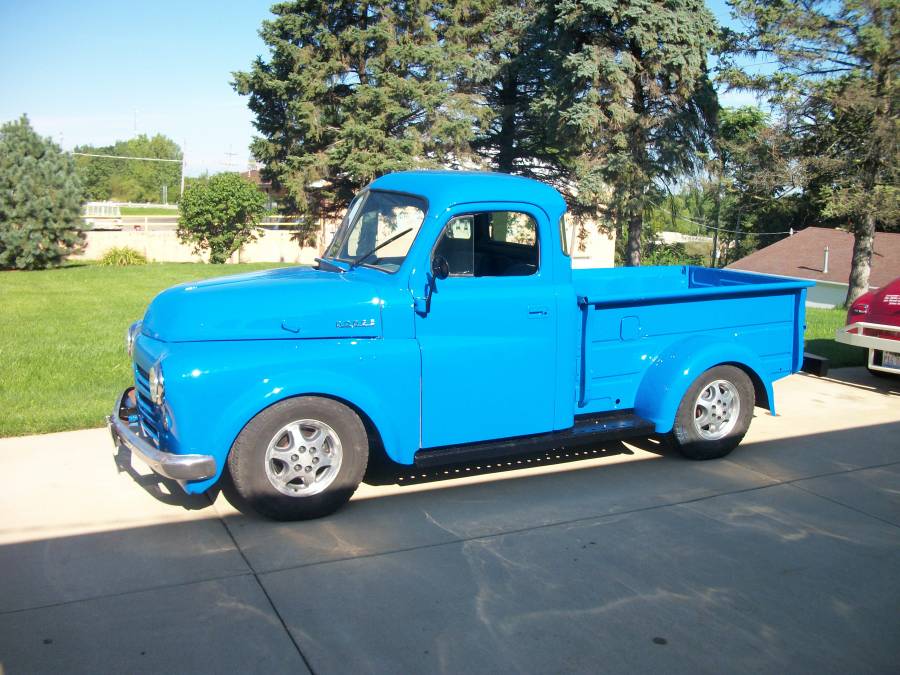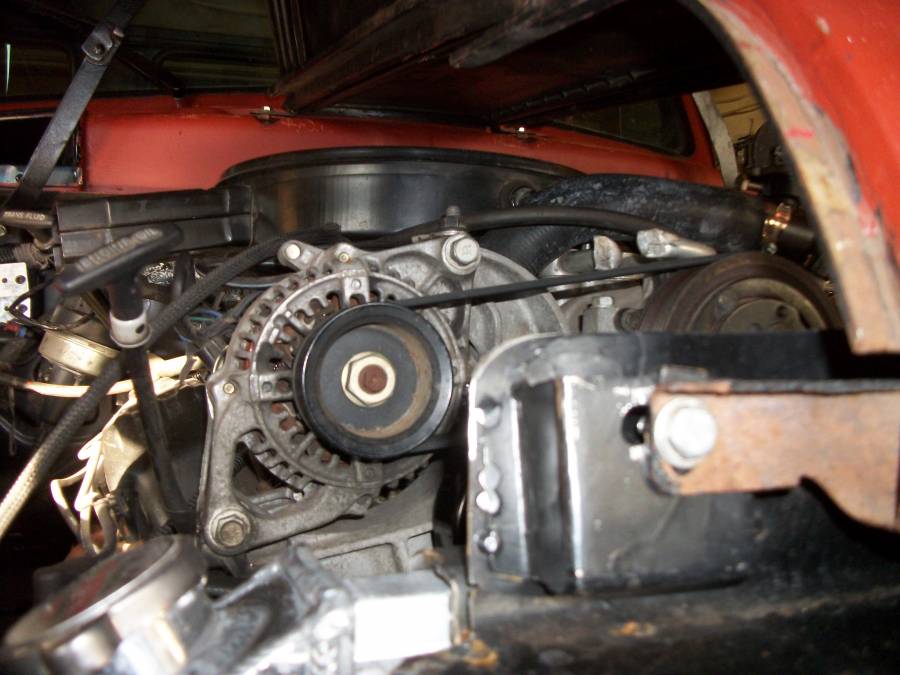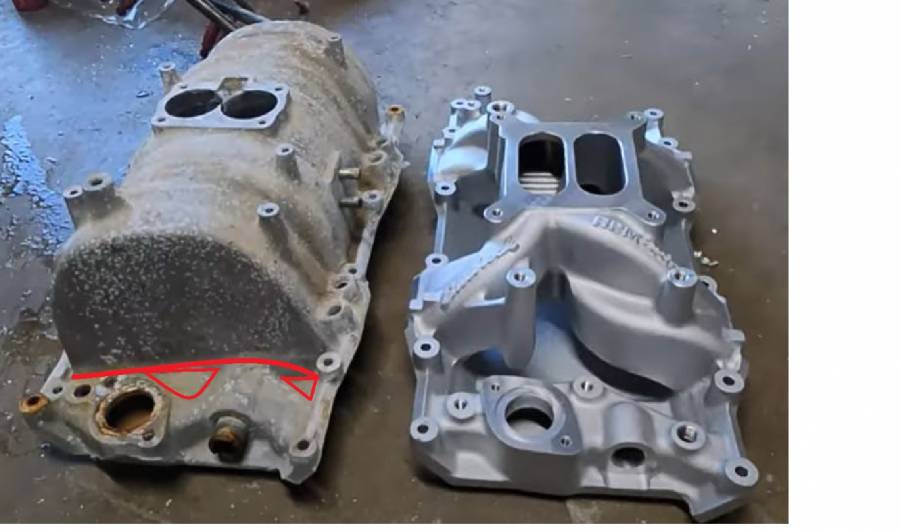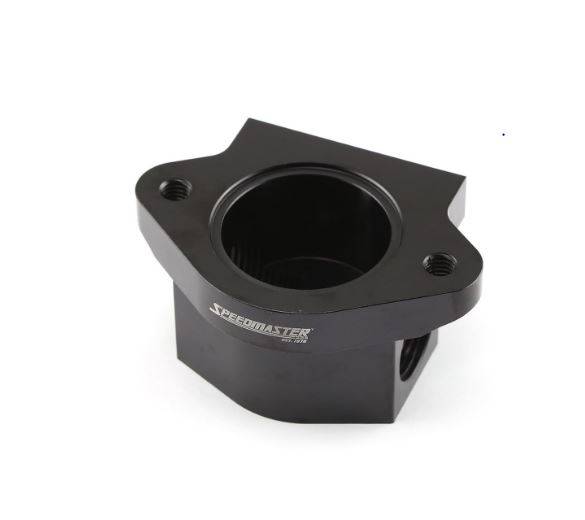|
 Re: Hughes F1 Air Gap intaketo a
[Re: Andyvh1959]
#3257407
Re: Hughes F1 Air Gap intaketo a
[Re: Andyvh1959]
#3257407
09/12/24 01:06 PM
09/12/24 01:06 PM
|
Joined: Jan 2005
Posts: 12,542
Kalispell Mt.
HotRodDave

I Live Here
|

I Live Here
Joined: Jan 2005
Posts: 12,542
Kalispell Mt.
|
Ive done a few things to minimize heat transfer to the air in there.
The easiest thing to do is to take 4 extra valve cover bolts with the studs sticking out the top and use them for the corner of the steel plate and use a couple nuts on the stud to hold a second plenum plate suspended below the actual plate.
You can also ceramic coat the plate to help keep heat out.
Last thing I have thought about doing would be to grind away the entire thermostat and coolant passage at the front leaving only basically a flange against the head, use a big drill bit to drill the coolant passages to a round shape, tap them, thread in two pipe nipples and plum in a remote mounted thermostat housing to keep the 200 degree coolant out of the intake.
I think the runner design in the keg is superior for low end TQ production but the immense heating of the air from both the giant coolant passage and oil from the crank case and cam negates all the gain from those long runners. If you watch the AIT on a scanner while driving around it is crazy how hot it gets even in zero degree weather 100 degree IAT is very common.
I am not causing global warming, I am just trying to hold off a impending Ice Age!
|
|
|
 Re: Hughes F1 Air Gap intaketo a
[Re: mgoblue9798]
#3257669
Re: Hughes F1 Air Gap intaketo a
[Re: mgoblue9798]
#3257669
09/13/24 09:59 PM
09/13/24 09:59 PM
|
Joined: Jan 2003
Posts: 11,028
Freeport IL USA
poorboy

I Live Here
|

I Live Here
Joined: Jan 2003
Posts: 11,028
Freeport IL USA
|
HRD there is a middle ground to be had temp wise by running a 160 or 180 thermostat and running a bigger radiator and electric fan set up. Magnums were designed to run hotter due to emissions and to squeeze every last bit of fuel mileage out.
Doing this on my 5.9 in my van made a huge difference in under hood and coolant temps. Temp gauge doesn't get over 185 now even towing another vehicle. Used to run at about 210 no matter what. Please understand me, I am trying my best to have a clear understanding of what is going on here. This old mechanic and racer didn't used to care much about fuel mileage, but back then fuel wasn't $3.75 a gallon either. Now that I no longer race, the shoe is on the other foot, fuel mileage has a slightly higher priority. So, is what you are saying as far as the current wisdom that a motor operates at its highest efficiency at 200 to 210 degrees, is incorrect? Isn't the highest efficiency point also the closest balance between power and fuel mileage? I understand that the goal to achieve the highest fuel mileage and the most power at the same time, are probably a contradiction of terms, but at some point those two things have to reach a crossroads (or at least come closest to each other) on their different paths. What is going on here is a few guys trying to determine where that closest point is between fuel mileage, and power out put, may lay, and what is needed to get there. Under the hood temps is an interesting thing. On my 49 Dodge truck, the high hood combined with the channeled body puts that 5.2 Magnum keg intake in some pretty warm air during the hot summers. I have discovered that ducting the fresh air for the intake from below the engine compartment has improved the summer performance, drivability, and fuel mileage. But in the winter months (the truck is driver year around in the north west corner of IL), I have to disconnect the fresh air tube and pull the warmer air from under the hood, or it stumbles and runs poorly. That 195 thermostat sure helps during the winter. I'm not so sure I'd be willing to give up the current winter driving performance for a slight gain through the summer. It is often the only transportation we use during the winter (because of the 4x4 option). I'm posting 2 pictures. Pic 1 is the side view of the truck. Its important to notice how far above the top of the fender line the top of the hood is. The truck's radiator cap is only about 3/4" above the top of the fenders. Pic 2 is a view with the camera sitting on top of the fender surface just in front of the hood, while the truck was still in red oxide primer. Everything above the top of the radiator cap is housed inside of the raised part of the hood from pic 1. That raised hood is about 8" above the top of the fender, and the top of the factory Dakota air cleaner housing is only 3" under the center of the hood. Everything you see in pic 2 is above the fender line on the truck, hanging around in hot (and probably not moving hot) air through the summer. My 49 sheet metal is channeled over an unmodified 93 Dakota 4x4 chassis. It has a 96 5.2 Magnum (mounted on replacement original Dakota motor mounts), coupled to an RE46 od auto trans, the Dakota 4x4 transfer case, front axle and rear 8 1/4 rear, both housing 3:55 gears. (Yes, the 4x4 functions and has been used.) The truck currently rides on 235 75 15 Goodyear Trailblazer tires (I have no clue the tire diameter). The truck has passed 25,000 miles of use since June of 22. On the highway @ 65 mph (in the summer), the truck pulls a very consistent 18-19 mpg, around town in the warmer months it averages 13 mpg, but that drops to 10 during the winter months (winter highway also drops about 3 mpg). At roughly 8,000 - 10,000 mile a year, fuel mileage matters. The truck weighs in around 4850 lbs, I'm not driving a light weight race truck here. This old man is pretty content with the performance of the truck, but the facts are, a steep incline @ 65, on cruise control, will drop the trans out of OD and unlock the converter to maintain the speed on the hill climb. Often it will shift back into OD and lock up the converter before it reaches the top of the hill. Squeezing a few more Ft lbs of torque at 2500 rpm wouldn't hurt, if it didn't cost a lot of money.  
|
|
|
 Re: Hughes F1 Air Gap intaketo a
[Re: poorboy]
#3257672
Re: Hughes F1 Air Gap intaketo a
[Re: poorboy]
#3257672
09/13/24 10:17 PM
09/13/24 10:17 PM
|
Joined: May 2012
Posts: 1,939
South Bend
John Brown

top fuel
|

top fuel
Joined: May 2012
Posts: 1,939
South Bend
|
My old low compression (10.3 to 1 actual) NHRA stocker would pick up .05 to .10 seconds with a 180 degree thermostat over 140 degrees without a thermostat. It had a radiator that would allow it to idle for an hour without overheating if necessary.
July 19th should be "Drive Like Rockford Day". R.I.P. Jimmie.
|
|
|
 Re: Hughes F1 Air Gap intaketo a
[Re: HotRodDave]
#3258010
Re: Hughes F1 Air Gap intaketo a
[Re: HotRodDave]
#3258010
09/15/24 06:51 PM
09/15/24 06:51 PM
|
Joined: Nov 2022
Posts: 269
Green Bay
Andyvh1959
 OP
OP
enthusiast
|
 OP
OP
enthusiast
Joined: Nov 2022
Posts: 269
Green Bay
|
I like those ideas. I have an extra kegger so I can study mods to limit heating the kegger. For cooler air under the hood I've thought about getting the center section of the hood louvered, maybe with the louvers facing forward.
Last edited by Andyvh1959; 09/15/24 07:00 PM.
My 56 C3-B8 Dakota build
|
|
|
 Re: Hughes F1 Air Gap intaketo a
[Re: poorboy]
#3258148
Re: Hughes F1 Air Gap intaketo a
[Re: poorboy]
#3258148
09/16/24 10:46 AM
09/16/24 10:46 AM
|
Joined: Nov 2022
Posts: 269
Green Bay
Andyvh1959
 OP
OP
enthusiast
|
 OP
OP
enthusiast
Joined: Nov 2022
Posts: 269
Green Bay
|
Exactly. That's why I thought the louvers would actually face rear opened rather than front, kind of like the cowl induction idea of the 60s era Chevelle. Then plan for an insulator panel to slide in place on the underside of the hood center for winter driving to block off the underhood opening. Since you have far more experience with these old Dodges you input is invaluable. I suppose when I get to that phase of the project I can perhaps design in some more structure to the center section of the hood that Dodge never planned to provide.
On the subject of cooling the kegger, looking at a visual comparison of a Kegger and an aftermarket air gap intake, its pretty clear there is an area on an aftermarket intake that mostly separates the coolant from the intake manifold. However, the air gap manifold also still maintains closing off the block valley. If a kegger were cut like the red lines indcate it would separate the coolant section of the intake from the air chamber, but it would also open up a gap into the block valley. Even if a piece were TIG welded in, it would also have to close off the gap eposing the block valley. The red lines indicate areas that really only close off the valley. The heavier red line indicates where perhaps the front of the kegger body could be cut from the area behind the thermostat and water passaages, and then TIG weld in bar stock to again seal off the intake side of the kegger body. But something would have to be welded back in, or bolted on from underneath, to close off the opening to the block valley. Would there be any real gain then in trying to separate the coolant portion of the kegger from the air intake portion?

Last edited by Andyvh1959; 09/16/24 02:21 PM.
My 56 C3-B8 Dakota build
|
|
|
 Re: Hughes F1 Air Gap intaketo a
[Re: Andyvh1959]
#3258211
Re: Hughes F1 Air Gap intaketo a
[Re: Andyvh1959]
#3258211
09/16/24 02:09 PM
09/16/24 02:09 PM
|
Joined: Jan 2003
Posts: 11,028
Freeport IL USA
poorboy

I Live Here
|

I Live Here
Joined: Jan 2003
Posts: 11,028
Freeport IL USA
|
Do you intend to make the cowl vent functional? If so, allowing warm air from under the hood out directly in front of the cowl vent may not be the best idea. If you don't intend to make the cowl vent functional, the rear facing louvers with a slide in panel to close it up during colder months (or hard rain) may work out OK.
I have considered adding a pair of smaller louvered panels at the back sides of both hood sides, but we also drive most of the summer with the door windows open. My cowl vent functions, so when its open, most of the time, the door windows are where the air inside the cab exits the cab. If the cowl vent is closed, there is a lot more wind noise inside the cab and you can feel the air coming in the open door windows.
Functioning AC would probably solve the under hood air venting issue, but the radiator on my 49 is almost against the grille, putting an AC condenser up there is going to be a challenge.
|
|
|
 Re: Hughes F1 Air Gap intaketo a
[Re: Andyvh1959]
#3258218
Re: Hughes F1 Air Gap intaketo a
[Re: Andyvh1959]
#3258218
09/16/24 03:12 PM
09/16/24 03:12 PM
|
Joined: Nov 2022
Posts: 269
Green Bay
Andyvh1959
 OP
OP
enthusiast
|
 OP
OP
enthusiast
Joined: Nov 2022
Posts: 269
Green Bay
|
Looking at the bottom of a modded kegger, seems the only other option could be an "air gap" bottom plate, kind of like mentioned earlier. If the bottom plate were a two level plate with the max gap between the two, it would at least keep the hot engine oil from contacting the bottom of the kegger plate. But without an actual inlet air gap at the front and outlet air gap at the rear of the kegger plate there would only be a gap to limit direct heating, but no actual air flow gap under the intale runners.
My 56 C3-B8 Dakota build
|
|
|
 Re: Hughes F1 Air Gap intaketo a
[Re: poorboy]
#3258223
Re: Hughes F1 Air Gap intaketo a
[Re: poorboy]
#3258223
09/16/24 03:54 PM
09/16/24 03:54 PM
|
Joined: Nov 2022
Posts: 269
Green Bay
Andyvh1959
 OP
OP
enthusiast
|
 OP
OP
enthusiast
Joined: Nov 2022
Posts: 269
Green Bay
|
Again, I'm hoping using most of the cab functions from my Dakota helps out here. I even plan to use the Dakota cab back wall vents (the ones between the cab back wall and box front wall) to help expell hot/higher pressure air from the cab. Since I also plan to use the entire Dakota windshield wiper system (hopefully with both sweeping the same direction) I do plan to not have a cowl vent at all. Without a cowl vent I can use that area under the cowl/dash for other systems.
Without the cowl it may allow me to plan for a louvered center section on the hood. SO much planning and designing. At some point I do have to start cutting/fabbing/welding/etc.
Does the area behind the grill bars and ahead of the radiator allow space for the AC condensor? Here again I hope to use all those components from my Dakota. AND, I have a tranmission cooler to plan for (the 8HP-70 trans has a cooler). But that may also mount at the back/underside of the cab if there is sufficient airflow underneath the cab. I will be changing the engine fan to electric, mounted to the backside of the radiator. That may allow for some extra room between the back of the radiator and the front of the engine, maybe.
My 56 C3-B8 Dakota build
|
|
|
 Re: Hughes F1 Air Gap intaketo a
[Re: Andyvh1959]
#3258291
Re: Hughes F1 Air Gap intaketo a
[Re: Andyvh1959]
#3258291
09/17/24 12:24 AM
09/17/24 12:24 AM
|
Joined: Jan 2003
Posts: 11,028
Freeport IL USA
poorboy

I Live Here
|

I Live Here
Joined: Jan 2003
Posts: 11,028
Freeport IL USA
|
Does the area behind the grill bars and ahead of the radiator allow space for the AC condensor? Here again I hope to use all those components from my Dakota. AND, I have a tranmission cooler to plan for (the 8HP-70 trans has a cooler). But that may also mount at the back/underside of the cab if there is sufficient airflow underneath the cab. I will be changing the engine fan to electric, mounted to the backside of the radiator. That may allow for some extra room between the back of the radiator and the front of the engine, maybe.
Things are pretty tight in front of the radiator on my 49. The most forward point on my original Dakota frame is the round holes that the radiator support used on the Dakota 4x4 frame. A 4x4 frame is different then a rwd Dakota frame, that may make a huge difference. I used the bottom 1/2 of the Dakota radiator support bolted into the original mounting holes on the frame because I started with the original Dakota radiator (that lasted about 4,000 miles and was replaced with a Champion aluminum radiator that better fit in my truck, after modifications to the mounting brackets. Pic 1 shows under the hood, looking straight down on the top surface of the original Dakota radiator. The factory clutch fan is still present in this picture, it had to be removed to make clearance for the electric fan attached to the new radiator, and make room for the rerouted upper hose. As you can see the red primed nose piece is very close to the radiator at the front. The only clearance between it and the radiator is the thickness of the nose piece itself, less the factory bent nose piece reinforced grille openings. If there is anything more then 2" of actual clearance, I would be surprised. Your 56 grille opening is completely open where the 49 grille openings are pretty much just slots cut into the sheet metal, so that too will help. Pic 2 this pic was taken during the inner fender portion of the build. We are looking at the front radiator mount bushing from inside the passenger side wheel well. The piece on the left top corner of the pic is the Dakota inner fender at the front end where it was cut off. The shiny black area below the inner fender is the Dakota frame, just to the right of the inner fender, and above the frame, you can see the rubber bushing that is the actual radiator supporting bushing. it is important to know that the outside diameter of the lower rubber bushing is 2" in diameter, that should give you a size reference of the things in the picture. The shiny new metal is the support piece that holds the front nose piece onto the radiator support. it is bolted to the nose piece (the large rusty looking piece at the bottom right side of the pic) with 3 1/4" bolts you can sort of see and is also bolted to the radiator support. That piece is in the form of a "Z" The small flange with the bolt holes is flat against the nose piece, with a 90 degree bend pointing straight back. the next bend is also a 90 degree bend that is welded to the front of the radiator support. The large piece that covers the right top corner is the sheet metal piece that the headlight is mounted to. Pic 3 kind of clears up pic 2. The 3 bolts to the left of the grill opening are the 3 bolts that hold the shiny metal to the nose piece, and you can see where it is welded to the radiator support. You can also se the back cover for the headlight holder. that has not yet been cut for the headlight mounting. The headlight holder is actually screwed to this sheet metal. You can also imagine the challenge of routing AC hoses or trans cooler lines into that area. Again, you have a rwd frame, not a 4x4, and the opening on the 56 Grille is wide open at the center. You may not have the problems I had.
|
|
|
 Re: Hughes F1 Air Gap intaketo a
[Re: moparx]
#3258464
Re: Hughes F1 Air Gap intaketo a
[Re: moparx]
#3258464
09/17/24 06:55 PM
09/17/24 06:55 PM
|
Joined: Nov 2022
Posts: 269
Green Bay
Andyvh1959
 OP
OP
enthusiast
|
 OP
OP
enthusiast
Joined: Nov 2022
Posts: 269
Green Bay
|
I am by trade a mechanical engineer and 30+ year trainer for both motorcycle rider classes and for hydraulic hose. So over the decades I've learned to be very specific and clear as possible when typing messages. But I am no where near the mechanic and fabricator the likes of Gene and others on this forum (Russ/Dabee). I have been my own motorcycle mechanic over 45 years and some of my bikes have miles getting close to 200,000. On a chassis swap I have a lot to learn. Gene has been priceless for practical solutions and realistic choices to avoid making mistakes once I really dig into this project. Gene's experience of multiple chassis swaps will hopefully make my 1st chassis swap/vintage build a well planned out success.
I previously worked 17 years as a chassis design engineer for Pierce Mfg on Class 8 fire trucks. I primarily did axles/brakes/air brake/ABS systems, but I learned a lot from my other coworkers about drivelines, cooling systems, engine/trans, and from a lot of test driving and training. Actually got to work directly with Bosch ABS engineers here in northern Minnesota and northern Sweden. That included developing test driving skills, surprisingly easy to spin a 40,000 lb fire truck, even on dry pavement. Just after I got a job in the hydraulic hose market I got an offer from Bosch to be their heavy truck ABS application engineer. But no way was I interested in relocating to Chicago, I'm a Wisconsin boy through and through, so I passed on that offer. Good thing too, because six years later Bosch ABS sold out to WABCO.
My 56 C3-B8 Dakota build
|
|
|
 Re: Hughes F1 Air Gap intaketo a
[Re: HotRodDave]
#3260801
Re: Hughes F1 Air Gap intaketo a
[Re: HotRodDave]
#3260801
09/29/24 06:10 PM
09/29/24 06:10 PM
|
Joined: Nov 2022
Posts: 269
Green Bay
Andyvh1959
 OP
OP
enthusiast
|
 OP
OP
enthusiast
Joined: Nov 2022
Posts: 269
Green Bay
|
This idea is intriguing. I have an extra kegger I bought cheap, so I could do much of what you detail. Machine out the entire current thermostat mount and coolant runs from the kegger. But I was thinking of having a friend TIG weld thick wall tube stubs onto the remaining ports for the coolant. Then use a remote thromostat mount with stubs plumbed into it for short hose runs to the stubs on the kegger. May also make for a cleaner/easier to access setup for the thermostat which right now on the 5.2 is kinda buried behind everything, and would make for cleaner hose routing from the radiator to the thermostat housing. This would nearly separate the hot coolant flow from the kegger entirely.
However, my 5.2 Magnum has the air conditioning compressor mounted right over where any possible tube or hose routing would have to route for a remote thermostat application. So that idea is out as I want AC in my 56 pickup. So I'll do what I can to isolate hot engine oil from the bottom of the kegger and leave it at that.

Last edited by Andyvh1959; 10/10/24 11:10 AM.
My 56 C3-B8 Dakota build
|
|
|
|
|

